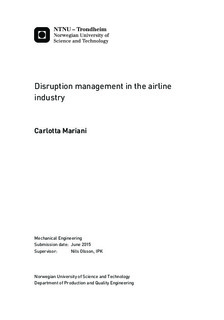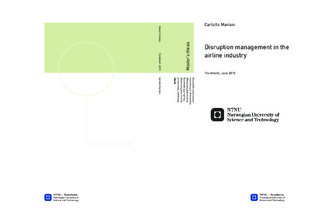| dc.description.abstract | The first point of the study purpose is taken into account in the second and third
chapter of this work. It helps to create the ground of the successive argument and
it also shows the main problem that could generate a delays or a disruptions in
the airline industry. We know that the structure of airlines is divided into various
phase and they are strategic, tactical and operational phases. part of the strategic
phase are Routes, Type of aircraft (size), Price / policy, Out-source and Planners.
The tactical phase is composed by Normal week plan, Supports, Aircraft flights
maintenance, Cycle Time and frequency of flight, Crew scheduling. Finally, the
operational phase is unrolled in Delay maintenance, Scheduling, Roll the plan,
Disruption management.
In all these phases can be possible to experience delays, but the phase most subject
to variations is the operational one.
Moreover, in the third chapter we investigate more precisely the planning operation
for the crew and also the airplanes, so the background is complete to develop
the main topic of the thesis.
To reply at the second statement point, one complete chapter in this work is
dedicated to this and it is the chapter six. The disruption situation originates in a
local event such as an aircraft maintenance problem, a flight delay, or an airport
closure or large traffic in the airport, but also for problems of crew and/or plane
scheduling or bad weather condition.
The plans for aircraft assignments, crew assignments and maintenance of the flight
schedule is handed over from the planning department to the operations control
centre (OCC) a few days days ahead of the day of operation. The deadlines are
different for different resources. Short-haul plans are usually handed over one day
ahead of the operation date, while long-haul information is handed over three to
five days before.
When one disruption comes, operations personnel in the airlines must find realtime
solutions so that it is able to replace the airline to its original schedule as
soon as possible.
An operations control center is required to make important operational decisions
with significant operational and commercial ramifications and often under extreme
time pressure and sometimes without complete information. Manual methods
often mean that only one or two possible solution options can be considered
with the prospect that a solution far from optimal across all the key areas may
be implemented. As a result of the sequential nature of manual processes, implemented
for one resource might very well have a profound impact on other areas.
In the chapter seven, it is address the problem of analysis of some datas from
the Avinor company and this is indicated as point three in the study purpose. It
is showed the more common charts and analysis to begin the dissertation about
the punctuality in the airlines. The company unfortunately didn t provide enough
material and informations for an accurate analysis.
For the sub-statements number four and five are fundamental the central chapters,
especially the number five and six, so in conclusion it is possible to affirm
that this section seeks to determine the difference between the approach of the
previous authors. Considering the high number of work related presented, it is
not possible to present a detailed comparison of their approach with each of the
works mentioned. However, it is possible to present the main differences. In their
opinion, their work is different from previous ones regarding the following key
features: the scope; technology ; integration; quality costs.
In the field of restoration of operations, there are three dimensions: aircraft, crew
and passengers. The authors classified its work according to the size that consider
an integrated approach when you are able to address two of these dimensions.
The authors work differs from the previous ones and in that it considers the three
dimensions of the domain. In this sense and to the best of their knowledge, their
approach is fully integrated.
Both aircraft recovery and crew recovery problems have been considered. Both
the aircraft recovery and crew recovery problems have been modelled as multicommodity
network flow problems where the underlying network is connection
network. The paper has also considered the correlation and dependency of two
problems. A new algorithm has been presented which solves aircraft recovery
and crew recovery problems sequentially and in interactive manner, in the paper
[62] and this could be the optimal solution. The subject algorithm takes into account
the dependency of two problems, represents the correlation between them
without integrating the two recovery problems.
Moreover, to reply at the substatement four, one complete section is dedicated
for that, in the chapter six. The MAS architecture, the multi-agent system is really
interesting and taken into account in this field of investigation. The agent and
service model were the outputs of this process and the base for this architecture.
Moreover, it could be iterated for all the agents with the exception of the Supervisor
agent.
It is important to capture the costs of delaying or cancelling a flight, from the
point of view of the passenger and not only from the point of view of the airline
company. The connected works that consider the cost of delaying a flight, assign
a cost to each minute of delay. In the authors opinion, this only captures
the cost from the point of view of the airline company because that cost is defined
by the airline and it is valid for all flights, without considering the profiles
of the passengers in the specific flight being affected by a disruption. The authors
approach uses quality costs that considers the opinion of the passengers on
the specific flights and that is one of the biggest differences regarding the related
work published so far.
To reply at the substatement six, there is all the chapter five that briefly says
that the Air Transport Association has estimated that there were a total of 116.5
million delay minutes in 2006, resulting in a $7.7 billion increase in direct operating
costs to the U.S. airline industry. Nonetheless, also in the United States, the
introduction in 2006 of airspace flow program (APPs) enabled the FAA to target
more precisely, en route, flights affected by weather. Because unaffected flights
could easily be excluded from ANSP interventions, this capability is estimated to
have reduced delay costs by $ 190 million over the first 2 years of implementation.
Determining more specifically which flights should be subject to, and which
exempt from, a ground-holding action triggered by reduced airport capacity remains
an open research question. Moreover, with the increase in air traffic is not
impossible to run into the resulting delays also due to the crowding airports. The
total direct operation costs in 2006 amounted $ 7,663 per minute ( $ millions) and
it is composed from fuel, crew, maintenance, aircraft ownership and others.
The cost scenarios are derived from independently concurring sources on total
passenger costs during 2003 . Two airline sources have also been used to rationalise
the equal split between hard and soft costs and we show that in total are
0.16, 0.36, 0.42 respectively for low base and high cost in percentage. Overall,
the total base cost scenario for 2008 is 20% higher than the value of 2003.
Finally, the discussion about the last sub-statement, the number seven, is developed
in the chapter eight. In it is underlined the influence of the new trends
in the overall airline industry, and in what way they should be changed also the
disruptions management and the manage of the delays.
There are three main changes to adopt to ATM. The first one is to utilize a new
4D principal trajectoryb. The second is a system wide information management
and the latest is the automation.
In that way it will be possible to enable EU skies to handle 3 times more traffic
than nowadays, at the same time improving safety by a factor of 10, reducing the
environmental impactper flight by 10 % and also cutting ATM costsby 50 %. | |

